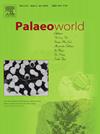阿根廷Carapacha组二叠纪木区系的新发现
IF 1.7
3区 地球科学
Q2 PALEONTOLOGY
引用次数: 0
摘要
Carapacha组由Calencó(下)和Urre-Lauquen(上)两段组成,根据其舌状植物区系可确定为二叠纪。该组露头位于拉潘帕省,靠近普埃尔切斯地区,沉积物为陆相、河流湖相。本研究描述了两个裸子植物树种。其中一个来自Calencó成员,属于法国Aveyron二叠纪的Scleromedulloxylon aveyronense,其特征是具有异细胞髓,具有岛状的厚壁细胞和横剖面上无组织的腔隙。另一个标本来自Urre-Lauquen段,是一种不确定亲缘关系的针叶树,Zalesskioxylon uniseriatum,以前报道过来自Raniganj(印度)、Yaguarí(乌拉圭)和Tacuary(巴拉圭)地层。这两种木材都具有古生代裸子植物的次生木质部特征,特别是在管胞壁的径向系统和凹坑的排列方面。这些木学记录证实,Carapacha组包含另一个二叠纪沉积序列,其中包含具有膜片螺线管髓的木材,例如在Melo(乌拉圭)、Río Bonito、Irati(巴西)、White Band(非洲)、Barakar和Raniganj(印度)组中发现的分类群。这种古植物群组合是冈瓦南二叠纪特有的Australoxylon xylotaphoflora的一部分。最后,本研究使我们推断出该地层的环境条件是温暖,低湿度和季节性干燥。本文章由计算机程序翻译,如有差异,请以英文原文为准。
New findings in the Permian xyloflora of Carapacha Formation (Argentina)
The Carapacha Formation consists of two members: the Calencó (lower) and the Urre-Lauquen (upper), dated as Permian based on its glossopterid flora. The formation outcrops in La Pampa Province, near the locality of Puelches, with sediments of continental origin, fluvio-lacustrine in type. This study describes two gymnosperm woods species. One, from the Calencó Member, is a Cordaitalean assigned to Scleromedulloxylon aveyronense found in the Permian of Aveyron, France, characterized by having a heterocellular pith with islands of sclerenchymatic cells and unorganized lacunae in transverse section. The other specimen, from the Urre-Lauquen Member, is a conifer of uncertain affinity, Zalesskioxylon uniseriatum, previously reported from the Raniganj (India), Yaguarí (Uruguay), and Tacuary (Paraguay) formations. Both woods exhibit secondary xylem features typical of Paleozoic gymnosperms, particularly concerning the radial system and the arrangement of pits in the tracheid walls. These xylological records confirm that the Carapacha Formation comprises another Permian sedimentological sequences that contain woods with diaphragm-solenoid pith such as the taxa found in the Melo (Uruguay), the Río Bonito, and the Irati (Brazil), the White Band (Africa), the Barakar, and the Raniganj (India) formations. This palaeofloristic association is part of the Australoxylon xylotaphoflora characteristic of the Gondwanan Permian. Finally, this study allows us to infer that the environmental conditions in this formation were warm with low humidity and seasonally dry.
求助全文
通过发布文献求助,成功后即可免费获取论文全文。
去求助
来源期刊

Palaeoworld
PALEONTOLOGY-
CiteScore
4.00
自引率
5.90%
发文量
95
期刊介绍:
Palaeoworld is a peer-reviewed quarterly journal dedicated to the study of past life and its environment. We encourage submission of original manuscripts on all aspects of palaeontology and stratigraphy, comparisons of regional and global data in time and space, and results generated by interdisciplinary investigations in related fields. Some issues will be devoted entirely to a special theme whereas others will be composed of contributed articles. Palaeoworld is dedicated to serving a broad spectrum of geoscientists and palaeobiologists as well as serving as a resource for students in fields as diverse as palaeobiology, evolutionary biology, taxonomy and phylogeny, geobiology, historical geology, and palaeoenvironment.
Palaeoworld publishes original articles in the following areas:
•Phylogeny and taxonomic studies of all fossil groups
•Biostratigraphy, chemostratigraphy, chronostratigraphy
•Palaeoecology, palaeoenvironment and global changes throughout Earth history
•Tempo and mode of biological evolution
•Biological events in Earth history (e.g., extinctions, radiations)
•Ecosystem evolution
•Geobiology and molecular palaeobiology
•Palaeontological and stratigraphic methods
•Interdisciplinary studies focusing on fossils and strata
 求助内容:
求助内容: 应助结果提醒方式:
应助结果提醒方式:


